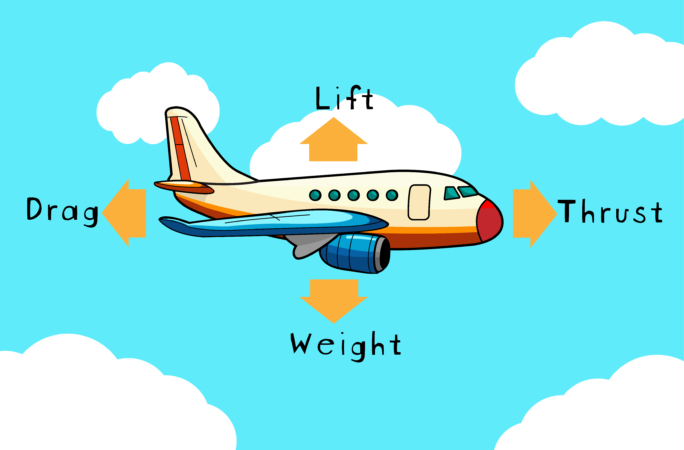Fast Facts
This article is for students grades 5-8.
-
Aerodynamics Defined: Aerodynamics is the study of how objects move through air, influencing everything from airplanes and rockets to kites and cars.
-
Four Forces of Flight: The four forces essential for flight are lift, weight, thrust, and drag, which interact to determine how an object moves through the air.
-
Understanding Lift: Lift is the upward force that must exceed weight for an object to rise; it is created by the wings of airplanes and other flying objects, utilizing specific shapes to manipulate air pressure.
- Thrust vs. Drag: Thrust propels an object forward, countering drag, which resists motion; a successful flight requires more thrust than drag to maintain speed and altitude.
Understanding Aerodynamics: How Things Fly
This article is for students in grades 5-8. Aerodynamics is the study of how objects move through air. It helps explain why airplanes soar high in the sky. From rockets blasting off to kites drifting lazily on the breeze, everything that moves through air follows aerodynamic principles. Even cars feel the effects of aerodynamics as they speed down the highway.
Four main forces drive flight: lift, weight, thrust, and drag. These forces affect how things move up and down, as well as how fast they go. The balance between these forces determines an object’s motion through the atmosphere.
First, let’s talk about gravity. Gravity pulls everything toward Earth. It gives weight to objects, which is critical for flight. For an airplane to take off, it must produce enough lift to overcome its weight. A light kite faces less weight than a jumbo jet, but both rely on lift to fly.
Lift is the upward force that allows objects to rise. It counteracts weight. All flying objects depend on lift. For an aircraft, this means creating more lift than weight. Hot air balloons generate lift because the warm air inside them is lighter than the cooler air surrounding them. Helicopters rely on rotating blades to create lift, while planes achieve this through their wing shapes.
The wings of an airplane are designed with curves. The top is more rounded, while the bottom is flatter. This design makes air travel faster over the wing’s top, resulting in lower pressure. The difference in pressure allows the wing to rise, lifting the entire airplane. This concept of using curves to manipulate air pressure appears in various designs, from helicopter blades to sailboats’ sails. A sail acts like a wing, propelling the boat forward.
On the other hand, drag works against movement. It’s the force that resists an object as it travels through air. For instance, moving through water produces more drag than moving through air. Shape influences drag too; rounded objects generally face less drag than flat ones, and narrower shapes encounter less resistance than wider ones. The greater the surface area that air strikes, the more drag acts on the object.
Thrust, however, propels objects forward. This force contrasts with drag. For an airplane to maintain speed, thrust must exceed drag. Small airplanes often use propellers for thrust, while larger ones rely on jet engines. Gliders don’t produce thrust; they can only glimmer in the sky until drag slows them down.
Aerodynamics plays a vital role in technology and space exploration. NASA, known for its innovative research, focuses on aeronautics, which is the science behind flight. The agency continually seeks to improve aircraft by studying aerodynamics. Additionally, understanding aerodynamics is crucial for missions beyond Earth. For example, spacecraft landing on Mars must navigate the planet’s thin atmosphere, making aerodynamics essential for exploration across different worlds.
In our daily lives and aerospace advancements, aerodynamics serves as a foundation for understanding how we fly and explore new territories. By grasping these principles, we can appreciate the science that shapes our world.
Continue Your Tech Journey
Stay informed on the revolutionary breakthroughs in Quantum Computing research.
Access comprehensive resources on technology by visiting Wikipedia.
SciV1

